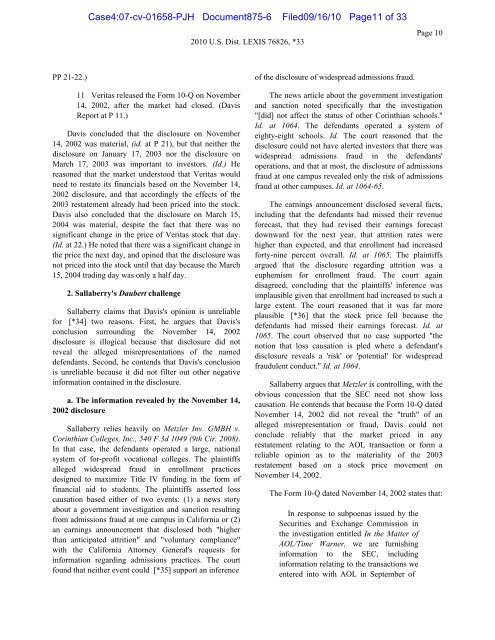exhibit 2 - SAP Lawsuit Portal
exhibit 2 - SAP Lawsuit Portal
exhibit 2 - SAP Lawsuit Portal
You also want an ePaper? Increase the reach of your titles
YUMPU automatically turns print PDFs into web optimized ePapers that Google loves.
PP 21-22.)<br />
Case4:07-cv-01658-PJH Document875-6 Filed09/16/10 Page11 of 33<br />
11 Veritas released the Form 10-Q on November<br />
14, 2002, after the market had closed. (Davis<br />
Report at P 11.)<br />
Davis concluded that the disclosure on November<br />
14, 2002 was material, (id. at P 21), but that neither the<br />
disclosure on January 17, 2003 nor the disclosure on<br />
March 17, 2003 was important to investors. (Id.) He<br />
reasoned that the market understood that Veritas would<br />
need to restate its financials based on the November 14,<br />
2002 disclosure, and that accordingly the effects of the<br />
2003 restatement already had been priced into the stock.<br />
Davis also concluded that the disclosure on March 15,<br />
2004 was material, despite the fact that there was no<br />
significant change in the price of Veritas stock that day.<br />
(Id. at 22.) He noted that there was a significant change in<br />
the price the next day, and opined that the disclosure was<br />
not priced into the stock until that day because the March<br />
15, 2004 trading day was only a half day.<br />
2. Sallaberry's Daubert challenge<br />
Sallaberry claims that Davis's opinion is unreliable<br />
for [*34] two reasons. First, he argues that Davis's<br />
conclusion surrounding the November 14, 2002<br />
disclosure is illogical because that disclosure did not<br />
reveal the alleged misrepresentations of the named<br />
defendants. Second, he contends that Davis's conclusion<br />
is unreliable because it did not filter out other negative<br />
information contained in the disclosure.<br />
a. The information revealed by the November 14,<br />
2002 disclosure<br />
Sallaberry relies heavily on Metzler Inv. GMBH v.<br />
Corinthian Colleges, Inc., 540 F.3d 1049 (9th Cir. 2008).<br />
In that case, the defendants operated a large, national<br />
system of for-profit vocational colleges. The plaintiffs<br />
alleged widespread fraud in enrollment practices<br />
designed to maximize Title IV funding in the form of<br />
financial aid to students. The plaintiffs asserted loss<br />
causation based either of two events: (1) a news story<br />
about a government investigation and sanction resulting<br />
from admissions fraud at one campus in California or (2)<br />
an earnings announcement that disclosed both "higher<br />
than anticipated attrition" and "voluntary compliance"<br />
with the California Attorney General's requests for<br />
information regarding admissions practices. The court<br />
found that neither event could [*35] support an inference<br />
2010 U.S. Dist. LEXIS 76826, *33<br />
of the disclosure of widespread admissions fraud.<br />
The news article about the government investigation<br />
and sanction noted specifically that the investigation<br />
"[did] not affect the status of other Corinthian schools."<br />
Id. at 1064. The defendants operated a system of<br />
eighty-eight schools. Id. The court reasoned that the<br />
disclosure could not have alerted investors that there was<br />
widespread admissions fraud in the defendants'<br />
operations, and that at most, the disclosure of admissions<br />
fraud at one campus revealed only the risk of admissions<br />
fraud at other campuses. Id. at 1064-65.<br />
The earnings announcement disclosed several facts,<br />
including that the defendants had missed their revenue<br />
forecast, that they had revised their earnings forecast<br />
downward for the next year, that attrition rates were<br />
higher than expected, and that enrollment had increased<br />
forty-nine percent overall. Id. at 1065. The plaintiffs<br />
argued that the disclosure regarding attrition was a<br />
euphemism for enrollment fraud. The court again<br />
disagreed, concluding that the plaintiffs' inference was<br />
implausible given that enrollment had increased to such a<br />
large extent. The court reasoned that it was far more<br />
plausible [*36] that the stock price fell because the<br />
defendants had missed their earnings forecast. Id. at<br />
1065. The court observed that no case supported "the<br />
notion that loss causation is pled where a defendant's<br />
disclosure reveals a 'risk' or 'potential' for widespread<br />
fraudulent conduct." Id. at 1064.<br />
Sallaberry argues that Metzler is controlling, with the<br />
obvious concession that the SEC need not show loss<br />
causation. He contends that because the Form 10-Q dated<br />
November 14, 2002 did not reveal the "truth" of an<br />
alleged misrepresentation or fraud, Davis could not<br />
conclude reliably that the market priced in any<br />
restatement relating to the AOL transaction or form a<br />
reliable opinion as to the materiality of the 2003<br />
restatement based on a stock price movement on<br />
November 14, 2002.<br />
The Form 10-Q dated November 14, 2002 states that:<br />
In response to subpoenas issued by the<br />
Securities and Exchange Commission in<br />
the investigation entitled In the Matter of<br />
AOL/Time Warner, we are furnishing<br />
information to the SEC, including<br />
information relating to the transactions we<br />
entered into with AOL in September of<br />
Page 10


